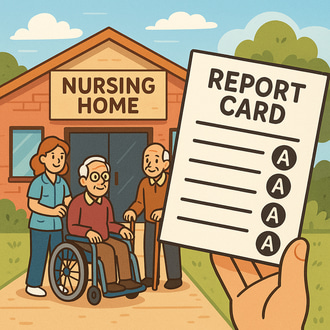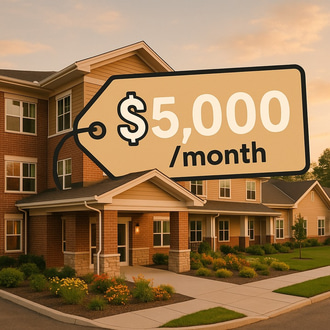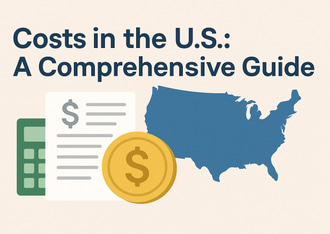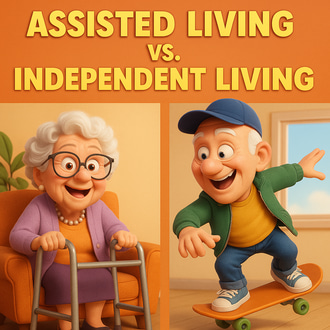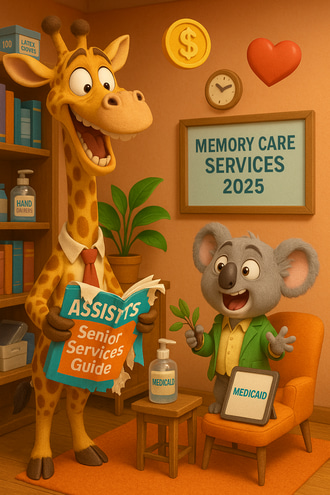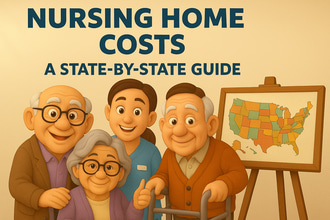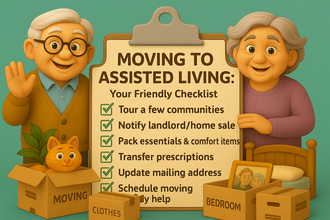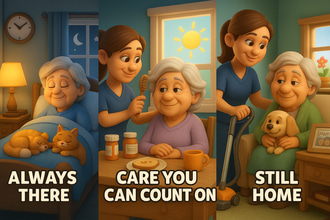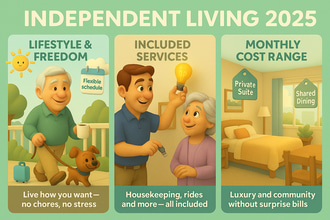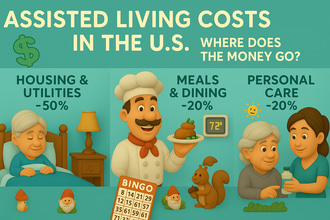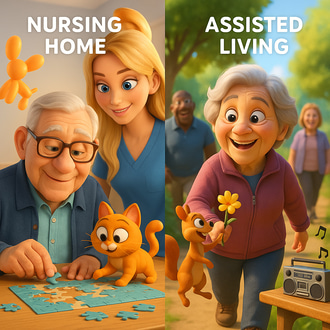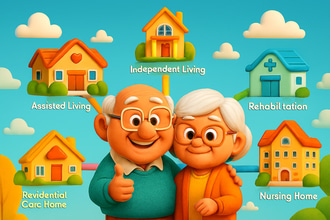Choosing an ideal assisted living community for your loved one is a major decision that can significantly affect their comfort and well-being. With so many options available, finding the perfect community can be challenging. Hence, we created a guide to help you understand assisted living, evaluate your options, and smoothly transition into the community.
Understanding Assisted Living
What Is Assisted Living?
Assisted living is a housing option designed to help older adults who require assistance with daily activities while maintaining their independence. In assisted living, residents are provided with private accommodations and help with tasks like bathing, dressing, and medication management in a safe, community-like setting.
Assisted Living vs. Other Senior Living Options
- Assisted Living
Assisted living communities provide 24/7 assistance for personal care without interfering with residents’ independence. Residents in these communities may need support with activities of daily living (ADLs) like medication management or personal grooming but do not require intensive medical care.
- Independent Living
Independent living communities are dedicated to active residents who can still care for themselves and live independently. These communities provide maintenance-free accommodations and convenient amenities like housekeeping services and social activities to keep residents entertained. Residents here do not have access to daily personal care or medical support.
- Nursing Homes
Nursing homes are designed to provide residents with complex and serious medical requirements with round-the-clock skilled medical care. Their care teams typically include licensed medical professionals and registered nurses, who focus more on providing treatments and medical monitoring.
Who Is Assisted Living For?
Assisted living is ideal for older adults who:
- Need assistance with daily activities like personal hygiene and medication management but do not require full-time medical care.
- Have mobility challenges.
- Have mild cognitive impairment but can still function well with guidance in a structured environment tailored for them.
- Feel isolated at home and would benefit from tailored activities and a social community.
If your loved one feels unsafe and unable to live alone but does not require nursing home care, assisted living can be an ideal option. It offers an ideal balance between independence, socialization, and support in a safe and secure setting.
Factors to Consider When Choosing an Assisted Living Home
Evaluating an assisted living community goes beyond just appearances and requires consideration of the following key factors:
1. Location
- Proximity to Family. A convenient location near loved ones leads to frequent visits from family members and emotional support.
- Community & Climate. Most older adults prefer a warmer climate and staying in their hometown. The weather can also affect residents’ comfort and the type of activities they can enjoy.
- Accessibility & Safety: Choose a safe area with proximity to hospitals, shops, and recreational spaces. Knowing the available transportation options and the community’s distance from families is also important.
- State Regulations: Each state has different assisted living regulations, which can affect care quality, inspections, and staffing. Sometimes, choosing a state with stricter regulations is ideal.
2. Cost
- Average Expenses. Depending on location and services provided, assisted living costs can range from $4,000 to $8,000 monthly. Find a community matching your budget and always request a complete fee schedule.
- Fee Inclusions. Monthly fees typically cover the accommodation, essential utilities, and basic care. Additional services like medication management and other amenities like a gym may cost extra. Make sure to request a list of the inclusions in monthly rent and services that cost extra.
- Fee Increases & Policies. Check the communities’ annual price hikes, added costs for increased care needs, and early move-out policies.
- Financial Assistance. Medicare doesn’t cover assisted living, but Medicaid waivers, long-term care insurance, VA benefits, and family contributions can help.
3. Quality of Care
- Staffing & Training. For proper attention, look for communities with an ideal caregiver-to-resident ratio of 1:8 during the day. It is also important to look for communities with trained caregivers, low turnover, and compassionate interactions.
- Medical Support. Verify if the community’s care team is available on-site 24/7 and whether licensed nurses are on duty or on call at all times. Check if healthcare providers also visit regularly or if the community partners with a home health agency and other healthcare providers.
- Emergency Response. Ensure the community is equipped with call buttons or pendants and has clear emergency protocols.
- Reputation & Resident Feedback. Read reviews, get feedback from current residents and families, and observe staff’s attentiveness and attitude to residents during visits.
4. Amenities and Services
- Dining Options. Assisted living communities typically provide three daily meals, which vary in flexibility and quality. Some offer any-time dining, multiple dining venues, or accommodations for special diets. Request a menu and, if possible, try a meal and observe how they handle meal service.
- Housekeeping & Laundry. Housekeeping services in assisted living usually include weekly cleaning and laundry. Take note of the frequency and availability of laundry facilities and incontinence-related laundry in the community.
- Transportation. Verify if the community offers scheduled group or personal transportation services. Inquire about their transportation schedule and check the accessibility of their transportation options and parking availability for those who can still drive.
- Recreational Activities. Seek a community with a robust list of activities, such as arts, book clubs, fitness classes, outings, and social events. Request to see an activity calendar, check residents’ participation levels, and confirm the availability of wellness programs like physical therapy.
- Health & Wellness Services. In some communities, they provide on-site wellness services, including therapy, regular wellness checks, and partnerships with home health agencies or hospice care.
- Exercise & Outdoor Areas. Check if there are relaxing and well-maintained areas like courtyards, walking paths, and fitness programs to help residents stay active.
- Social Opportunities: See if there are informal gathering areas and resident-run clubs to help residents maintain social connections.
- Pet Policy: Some facilities allow pets with restrictions and fees, while others only permit therapy animals.
- Resident Satisfaction & Atmosphere: Observe resident engagement and interactions. Happy, social residents indicate a strong community.
5. Facility Cleanliness & Safety
- Cleanliness & Maintenance. Observe the community’s cleanliness and sanitation. or disrepair can indicate poor sanitation and maintenance practices. Ask if the community also had any issues during health inspections.
- Safety Features. Ensure safety features are installed in the community, including grab bars, clear emergency exits, backup power systems, and non-slip flooring.
- Security: Check for security measures like controlled access, visitor sign-ins, and secured doors for memory care communities. Inquire if a staff member is also available on-site 24/7.
6. Community Culture & Resident Satisfaction
- Staff-Resident Relationships. Observe staff and resident interactions. Note how staff addresses residents, their tone, and how they handle them. See if the management or directors also know residents on a personal level. See if the management or directors also know residents on a personal level.
- Activity Participation. A vibrant community encourages social interaction. Low turnout at events may indicate dissatisfaction.
- Feedback & Resident Voice: Look for communities that allow residents to express their voices through resident councils and open feedback systems.
- Overall Atmosphere: Choose a place where your loved ones can meet like-minded individuals with similar activity levels and personalities. Note if residents look happy, clean, and well-cared for. Also, find a few residents who stayed the longest in the community and ask about their level of satisfaction and contentment. Trust your instincts—comfort and happiness matter as much as care quality.
Researching and Comparing Assisted Living Homes
Once you’ve identified potential communities, conducting a thorough research and comparison is the next crucial step to make an informed choice. Below are some helpful ways to effectively compare your options.
1. Conduct an online research using directories and comparison tools. Look for state government resources and trusted senior care websites that maintain online directories of licensed assisted living communities. Make sure to verify if the site has facility-sponsored listings, which can affect its bias and ratings. Check for information on recent inspection reports, ratings, complaints, and violations of your potential communities.
2. Read Reviews & Testimonials. Check Google Reviews, Yelp, and senior care review sites for every community on your lists. Look for patterns or recurring issues that indicate red flags, like staffing shortages or unresponsive care. Ask the facility for testimonials or to connect you with current residents’ family members to hear directly from them. Keep in mind that reviews can sometimes lean more on negative aspects as unhappy people may be more motivated to post. If something from the reviews concerns you, ask about it when you visit the community.
3. Check for any Complaints & Violations. Look for any unresolved complaints about the communities on your list in state licensing databases and the Better Business Bureau (BBB). Connect with a local long-term care ombudsman to ask about any notable complaints about your prospect communities.
4. Create a Comparison Chart. Keep track of factors like amenities, monthly cost, past violations, staff-to-resident ratio, and specialized services by creating a comparison chart or spreadsheet of your potential communities.
5. Verify Claims. Since marketing materials can be misleading, it is important to check the legitimacy of community claims like “award-winning care” or “24-hour nursing,” ask for specifics, such as type of award and the provider of the award.
Through thorough research you can narrow down top options before scheduling visits. Keep in mind that the more informed you are, the better judgment you can make for your loved one’s future community and well-being.
Visiting and Evaluating Assisted Living Facilities
An in-person visit is perhaps the most crucial step when choosing an assisted living community. It allows you to assess the community’s environment, staff, and care quality. Here’s what to do to make the most of your visits:
1. Schedule Visits. Tour at different times of the day to observe activity levels, observe during mealtimes, and assess staffing levels in the evening. If possible, make a surprise visit to experience a more authentic atmosphere when they are not prepared for a tour.
2. Prepare. Dress comfortably and bring a camera to take pictures of the things you want to remember later. If your loved one is able and willing, bring them with you to get their feelings and thoughts about the community. Make a complete checklist and list of questions to ask about during your visit beforehand.
3. Make thorough assessments and observations. Observe everything as you’re being shown around, and take note of the following:
- Your tour guide’s demeanor.
- Staff members’ interactions with residents.
- Residents’ appearance, grooming, and mood.
- The cleanliness and safety of the environment.
- The meals are served to residents.
4. Participate in Activities or Meals. Most communities ask families to join residents’ activities and mealtimes during visits. Take advantage of this to see how the activities are conducted and how residents respond. During the meal, note whether they’re using fresh, healthy ingredients, observe how they assist residents needing meal assistance, and handle special diets.
5. Keep an eye out for red flags. As you visit, take note of some of the following red flags;
- Poorly groomed residents, as well as dirty common areas and bathrooms.
- Stressed, rude, and not well-trained staff members.
- An eerily quiet atmosphere with very few residents.
- Cluttered hallways and safety hazards like unorganized cords and poor lighting.
- Frequent unanswered call bells or alarms.
- Vague or evasive answers to important questions.
6. Compare and Debrief. Review notes with family and narrow down top choices.
Key Questions to Ask
To better help you during visits and evaluation, here’s a list of important questions you need to ask:
Care & Staffing
- What is the staff-to-resident ratio?
- Are nurses available 24/7?
- How often are care plans updated?
- How long have some of your key staff been here?
- How many caregivers are on duty in the day vs. at night?
- Do you have a doctor or medical team that visits the community?
Services & Fees
- What is included in the monthly cost?
- How are additional services priced?
- Do you accept Medicaid waivers?
- What happens if a resident runs out of funds?
- Do you have an entrance fee or community fee, and is it refundable?
Apartment & Community Policies
- What room layouts are available?
- Are personal furnishings allowed?
- What are the visiting hours?
- Is housekeeping provided, and how often?
- What is your pet policy?
- Do you allow overnight guests in the apartments?
Medical & Safety Measures
- How is medication managed?
- What are the emergency response procedures?
- What security measures are in place?
- Do you ask residents to move out or transfer to another level of care, and under what conditions?
Lifestyle & Activities
- Can residents personalize schedules?
- What hobbies or social events are available?
- Do you have special features (salon, pool, etc.), and do they cost extra?
- Do you have exercise or wellness programs?
Dining and Food
- Do you have alternate meal choices each day?
- What is your dining schedule, and are they flexible?
- Do you have room service, and does it have a fee?
- How do you accommodate special diets or food allergies?
Feel free to voice your concerns during visits and ask open-ended questions that reveal more about their strengths and weaknesses. Take the time to thoroughly evaluate communities to make sure you find the best possible option for your loved one’s comfort and happiness.ou find the best possible option for your loved one’s comfort and happiness.
Reviewing Contracts and Policies
Once you’ve chosen an assisted living community, reviewing the contract carefully before signing is the next important step. These agreements spell out the services, costs, and resident responsibilities, which is why it’s essential to understand every detail stated thoroughly.
- Service Agreement & Fees—Make sure the contract matches all services promised verbally and provides a detailed breakdown of monthly costs, additional fees, and how rates may change over time.
- Refund & Cancellation Policy—Check termination clauses, including what happens if your loved one leaves early and whether entrance fees are refundable. It is also important to check what happens if a resident passes away.
- Scope of Care & Transfer Policies—Understand care limitations and when a resident may need to move to a higher level of care.
- Resident Rights & Dispute Resolution—Ensure the contract covers the basic rights and understand how to report concerns internally through the complaint or grievance procedures section. Be cautious of arbitration clauses that limit legal options.
- Health Care Provisions—Review policies on medication management, emergency response, and transitions to hospice or skilled nursing.
- Rules & Regulations—Familiarize yourself with the policies on visitors, pets, smoking, personal property, and quiet hours.
- Termination Notice—Check how either party can terminate the contract. Typically, both sides are given 30 days’ notice. This section protects residents from sudden eviction.
When reviewing contracts, seeking legal advice to help clarify complex terms or unfair clauses is important. Double check to make sure everything agreed upon is in the contract and never sign under pressure. A well-understood contract prevents you from facing unexpected fees or policy issues and guarantees a smooth transition for your loved one.
Making the Final Decision and Transitioning
After thorough research and careful deliberation, it’s time to finalize your decision and help your loved one transition smoothly into their assisted living community. Here’s how;
Finalizing the Decision
- If you have two or more communities on your short list, finalize your option with family members by comparing cost, care quality, and atmosphere. Consider your loved one’s preferences and thoroughly weigh each community’s pros and cons.
- After choosing your final community, sign the contract, pay any deposit, and complete the required medical forms to secure the spot. Clarify the move-in date and logistics and prepare for the move.
Preparing for the Move
- Involve your loved ones in sorting and packing their belongings. It is important to downsize and choose meaningful items that make them feel cozy and familiar in their new space.
- Verify facility rules on move-in timing and procedures. Label boxes clearly for an organized setup, and decide whether to use a moving company or do it with the family’s help
- Arrange furniture and décor for comfort and safety. Set things up similarly to their old homes while keeping pathways clear of tripping hazards.
- Before the move, ensure your loved one’s prescriptions are transferred to a pharmacy that delivers to the community and schedule medical check-ups as needed.
Helping Your Loved One Adjust
- Stay present in the early stages of your loved one’s transition. Join them in meals or activities until they feel comfortable on their own.
- Regularly visit and stay in touch with staff to address concerns immediately.
- Encourage them to engage in activities and socialize with others.
- Stay patient and supportive as they adjust and acknowledge the emotional roller coaster they may feel.
Staying Involved Post-Move
- Visit and communicate with your loved one regularly. Monitor your family member’s well-being and let the community know you’re engaged in their care while respecting their independence.
- Join family meetings and events. Take this opportunity to stay informed about changes and advocate for improvements if needed.
- Support your loved one’s emotional well-being by validating their feelings, making them feel seen, encouraging them to share stories, and celebrating positive changes.
A steady transition ensures that your loved one receives their needed care and support to grow in their new home.
Bottomline
The search for the right assisted living community can be challenging and demand intensive research. Still, these steps ensure your loved one finds a comfortable and nurturing community that matches their needs. By understanding assisted living, evaluating options, and compassionately guiding your loved ones through the transition, you are helping them enjoy a safer and more fulfilling next chapter of their lives.
Although no community is perfect, the right fit for your family member is out there. Take your time, involve your loved one, and trust the process. Soon, you’ll have peace of mind knowing they are in good hands.
Despite its challenges, transitioning to assisted living can also bring comfort, relief, and happiness to your loved one, who’ll receive care and companionship, and you, who’ll receive peace of mind from knowing they are well-cared for and thriving.



